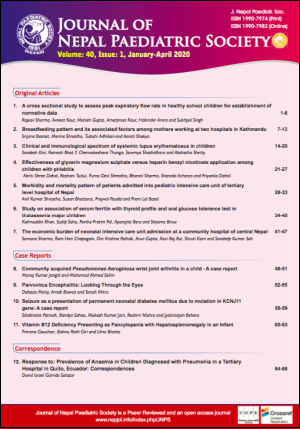Breastfeeding Pattern and its Associated Factors Among Mothers Working at Two Hospitals in Kathmandu
DOI:
https://doi.org/10.3126/jnps.v40i1.21186Keywords:
exclusive breast feeding, expression of breast milk, nursing break, prelacteal feedAbstract
Introduction: Breastfeeding practices of women working at the hospital are likely to be modified by the facilities and support that they receive at the hospital. This study was done to evaluate the breast feeding practices and to analyse important factors that are associated with exclusive breast feeding till six months among women working at hospitals in Kathmandu, Nepal
Methods: A total of 110 women, with a young child between the ages of six months and two years were recruited from two hospitals in Kathmandu. A predesigned structured, interviewer-administered questionnaire was used for data collection.
Results: The mean age of the mothers was 29.85 ± 3.68 years. Ninety seven (88.2%) women were aware about initiation of breastfeeding within first hour of birth but only 64 (58.2%) women could practice it. Most women 100 (90.9%) were aware about exclusive breastfeeding but only 18 (16.3%) could practice exclusive breastfeeding till six months. Mean duration of exclusive breastfeeding was 2.86 ± 2.00 months and 20 (18.2%) mothers practiced mixed feeding since birth. The participants whose babies had prelacteal feeding had significantly shorter duration of mean exclusive breast feed {1.92 ± 2.18 (S.D)} compared to those who did not have prelacteal feed {3.33 ± 1.74 (S.D)} (p = 0.001). Those who delivered by normal vaginal delivery, initiated breastfeeding within first hour of delivery, expressed breast milk and got feeding breaks were associated with longer duration of mean exclusive breast feed.
Conclusion: The breast feeding practices among working women at hospital is quite low compared to national statistics on IYCF. Breast milk expression and feeding breaks for lactating working women could improve feeding practices.
Downloads
Downloads
Published
How to Cite
Issue
Section
License
Authors who publish with this journal agree to the following terms:
Authors retain copyright and grant the journal right of first publication with the work simultaneously licensed under a Creative Commons Attribution License that allows others to share the work with an acknowledgement of the work's authorship and initial publication in this journal.
Authors are able to enter into separate, additional contractual arrangements for the non-exclusive distribution of the journal's published version of the work (e.g., post it to an institutional repository or publish it in a book), with an acknowledgement of its initial publication in this journal.
Authors are permitted and encouraged to post their work online (e.g., in institutional repositories or on their website) prior to and during the submission process, as it can lead to productive exchanges, as well as earlier and greater citation of published work (See The Effect of Open Access).



